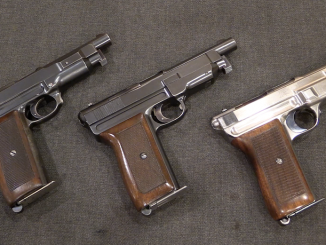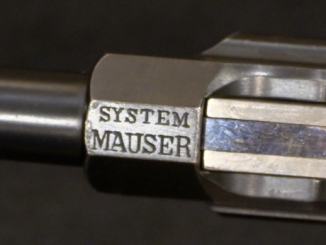In 1932, Walther made 10 custom long-barreled PP pistols for the Swiss target shooting community, sold through Glaser in Switzerland. These pistols had 127mm (5 inch) barrels chambered for .32 ACP, a fine satin “Verchromt” finish, extra checkering on the front and back straps, and a gold-plated trigger. Very fancy!
Make sure to check out Legacy Collectibles’ YouTube channel!, as well as their online shop for lots of high-end collectible firearms.




Why do I get the idea that the only way to make this even fancier is to Damascene the gun and have it held by 007? Just kidding!
Wouldn’t that serial number range mean 11 guns, not 10?
Yes, yes it does.
Most normal guns with serial numbers like that would normally just go to 10. But these go to 11.
OK, you win 🙂
Anyone have any insight as to how difficult it was to make the frame longer? The bbl, not so much, the slide, ooof.
I wonder what effect on operation the additional weight of reciprocating parts has?
Longer barrel needs bigger slide mass…. For 2 milimeters unsupported initial blowback for 10 centimeters barrel needs some 270 grams of slide weight and 12,5 centimeter barrel needs approx. 360 grams… IMHO…
Those scratches above the trigger on the left side looks very much as though someone tried to put their name there. I would like to have a Walther with the same barrel lenght as this, only in 9mm P.
Walther tried that twice prior to the P.38. First with the Walther Model 6 blowback 9mm during World War 1;
https://www.forgottenweapons.com/ria-walther-model-6-video/
And again with the Walther Militarpistole 9mm pistol prototype in 1929;
https://64.media.tumblr.com/7614c1c281076600cd6fd44265b610ff/tumblr_inline_o56qu5QKWl1qapn73_500.jpg
While about 1,000 Model 6 pistols were made from 1915 to 1917, less than a dozen Militarpistoles were made. In each case, Walther found that their basic blowback design did not stand up well to the recoil forces and pressures of 9 x 19mm.
cheers
eon
“Walther tried that twice prior to the P.38.(…)”
There was also at least another one attempt at 9×19 mm Parabellum-chambered automatic pistol by Walther, which is known as Walther toggle action pistol, see photos:
http://historypistols.ru/blog/pistolety-pod-unitarnyj-patron-avtomaticheskie/eksperimentalnyj-pistolet-valter-s-rychazhnym-mexanizmom-zapiraniya-walther-toggle-action-pistol/
it said to be created in mid 1920s. Interestingly magazine capacity was 16. Remained purely experimental.
Yeah, the reason the Russians ended up with 9x18mm for the Makarov is because that’s about as powerful as you can go in a straight blowback gun without needing an excessively heavy slide and bolt. Hi-Points aside, that’s why you don’t see many pure blowback handguns in 9×19 or bigger.
Not only.
They returned to this at the end of the war.
And they even succeeded.
Walther, you know what we need.
Joke content: “The name is Walther. Carl Walther.”
Silliness aside, it appears that Walther understood that one needed to compete in order to develop and grow. Good products are seldom, if ever, produced in complete isolation.
“…Walther understood…” (C)
Exactly.
In the past time.
Today, even with CNC machines and 3d CAD and CAM systems you could never get a major manufacturer to do that. Can you imagine how much effort that took in the age of forged components and machining done on long lines of manual machinery?
Today, with CNC machines and 3D CAD and CAM systems, you can do the same thing, but twice, if not five, better. Although it may be more expensive.
But Walther prefers to use all these technologies to make everything cheaper, forgetting about quality and reliability.
As if they do not understand that they are physically incapable of competing in quality and price, for example with the Turks.
This is not the first I have heard of competition target guns in 7.65/.32. Ortgies pistols, of all things, for awhile took some championships. It might be interesting to know more about the interwar rise and fall of this cartridge in target competition — I have read that it is inherently accurate, and the semi-rim seems not to give trouble even in the full-auto Vz.62. .22 is cheaper of course, but a little less reliable. Perhaps here is a niche for a .32 revival?
“(…)Vz.62(…)”
What do you mean under that?
“(…)Perhaps here is a niche for a .32 revival?”
Are there any shooting competitions with rules, which does promoted this cartridge?
In interwar Germany, all handgun calibers 8 mm and above were considered military by the International Military Control Commission, as well as handguns with a barrel length of 100 mm or longer. As such they were illegal.
At the same time “gebrauchsmäßiges” (meaning use-oriented for self-defence) shooting became very popular in the volatile overall situation. This included rapid fire stages.
Therefore, the caliber choice for a civilian was very limited and 7.65/.32 nearly the only option. Even 9 short/.380 counted as military and was illegal. Revolvers were not very popular, the U.S. models also extremely expensive.
With regard to rapid fire stages, the 6.35/.25 Walther Model 8 was very popular for these and this use is also the reason why 6.35 Walther PP exist. As always in sports, the original aim of self-defence was sacrified for a few points more.
The rise of Smallbore was also a result of the political situation. But while rifles were soon offered, pistols came rahter late. I think the Stock was the first. Heinrich Hax at the 1932 Olympics in Los Angeles won his Olympic Rapid Fire silver medal with a loaned Colt Woodsman.
“(…)I think the Stock was the first.(…)”
I suspect RÖMERWERKE automatic pistol might be bit earlier, it has interchangeable parts allowing changing caliber between .22 and 6,35 mm.
Zhuk does date it to 1925 year, see 33-131 drawing: http://earmi.it/armi/atlas/212.htm
Hello